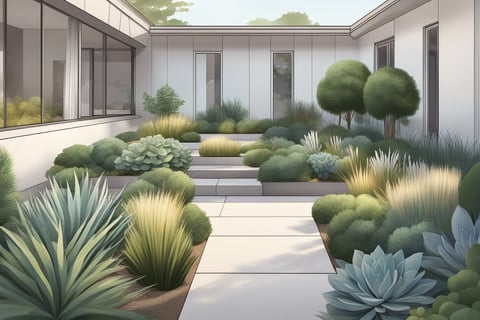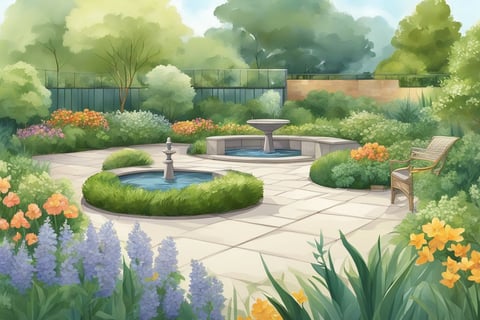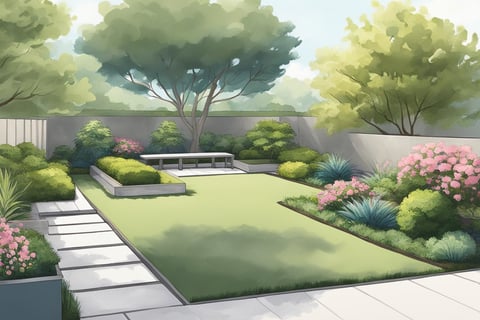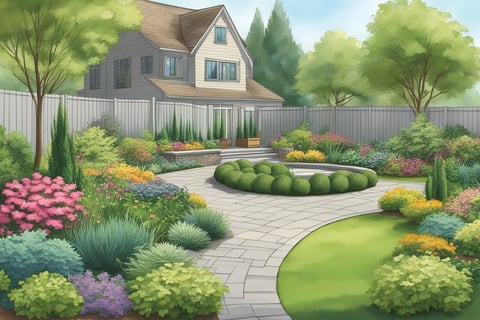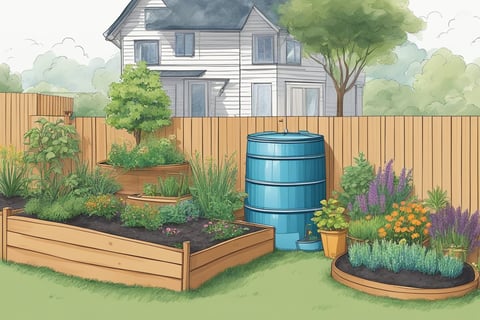Effortless Garden Ideas: Low-Maintenance Designs for Busy Homeowners
Want a beautiful garden without the constant upkeep? This guide is packed with easy-care plant recommendations, simple garden layouts, and smart landscaping tips for busy homeowners. Learn how to design a stunning, low-maintenance outdoor space that thrives with minimal effort, so you can enjoy a lush garden without the hassle. Perfect for those with a packed schedule but a love for green spaces!
11/9/20249 min read
Low-Maintenance Garden Designs for Busy Homeowners: Easy Plant and Layout Ideas
For homeowners who are constantly on the go, maintaining a lush garden may seem like an arduous task. Thankfully, there are numerous garden designs that demand less time and effort while still creating a beautiful and inviting outdoor space. Selecting the right combination of garden layouts, plant varieties, and landscaping techniques can significantly reduce the need for continuous upkeep.
Opting for perennial plants is a great way to ensure your garden thrives year after year with minimal maintenance. Perennials return each season and often require less watering and fewer nutrients compared to annuals. Complementing these with native species can enhance the garden's resilience and further reduce the need for attention.
Incorporating automated irrigation systems and choosing low-maintenance materials for paths and borders can simplify garden care. These choices ensure that even with a hectic schedule, homeowners can still enjoy the tranquility and beauty of nature without constant intervention. This approach to gardening not only conserves time but also supports sustainable living practices.
The Essentials of Low-Maintenance Garden Design
Creating a low-maintenance garden involves choosing plants suited to your garden's climate and zones, maintaining soil health, and setting up efficient irrigation. Each aspect helps reduce the time and effort needed to keep the garden thriving.
Understanding Garden Zones and Climate
Garden zones, defined by temperature and growing conditions, play a crucial role in plant selection. Utilizing USDA Hardiness Zones or similar guidelines helps identify plants that can thrive locally, reducing the need for constant care. Choose native plants or those adapted to the specific climate, as these will naturally require less attention.
Perennial plants are excellent for low-maintenance gardens. They return each year without needing to be replanted. Evergreens, hardy shrubs, and drought-resistant species are ideal choices. Using a mix of these plants ensures year-round interest and reduces the workload.
Soil Health and Improvement
A garden's success heavily relies on the health of its soil. Prioritizing soil quality reduces time spent on interventions later. Regularly adding organic matter like compost or aged manure enriches the soil with nutrients, enhancing plant growth. Mulching helps retain moisture and minimize weeds.
Testing soil pH is important to understand nutrient availability. Amendments like lime or sulfur can adjust pH, ensuring plants access needed nutrients. Low-maintenance does not mean neglecting soil health; instead, it involves preventative measures for sustained plant health.
Irrigation Solutions for Easy Care
Efficient irrigation is key to minimal upkeep. Drip irrigation systems offer precise watering directly to plant roots, reducing water loss and promoting healthy growth. Installing a timer ensures consistency, especially useful for busy homeowners.
Rainwater harvesting complements irrigation efforts by utilizing collected rainwater. Not only does this save on water bills, but it also makes use of an otherwise wasted resource. Soaker hoses and moisture sensors can also be incorporated for better water management.
Maintaining low-maintenance gardens requires planning and the right tools. By focusing on appropriate plant selection, soil health, and watering systems, garden care becomes more manageable and enjoyable.
Selecting the Right Plants
Choosing the best plants is crucial for a low-maintenance garden. Opt for drought-tolerant, perennial, and native varieties to ensure that your garden thrives with minimal effort and fewer problems caused by pests.
Drought-Tolerant Varieties
Drought-tolerant plants are ideal for homeowners who want to reduce water usage and gardening time. These plants can survive extended dry periods without frequent watering. Succulents like Aloe Vera and Sedum are excellent choices, retaining moisture in their leaves.
Additionally, lavender not only withstands drought well but also adds a pleasant scent. Yucca is another resilient option, thriving in hot, dry conditions with little care. Using mulch can further enhance moisture retention and reduce the need for constant watering, making garden upkeep even more manageable.
Perennials Over Annuals
Perennials return year after year, reducing the effort required for replanting each season. These plants support long-term growth, mainly if selected for your climate and soil type. Daylilies and hostas are popular choices, requiring little care once established.
By choosing perennials, gardeners save time and resources, as these plants often need less water and fertilization compared to annuals. Additionally, they tend to be more resistant to pests and diseases. Grouping plants with similar needs can also simplify maintenance tasks, ensuring a cohesive and easy-to-care-for garden space.
Native Plants for Fewer Pests
Native plants are naturally adapted to the local environment, making them more resilient and less prone to pests. These plants require less intervention, including pesticides or fertilizers. Native wildflowers such as coneflower and black-eyed Susan can enhance the natural beauty of a garden while benefiting local pollinators.
Many native grasses, such as switchgrass, offer robust growth and require minimal watering. These plants' inherent adaptation to the region’s climate and soil types ensures their success with little interference. Incorporating native species not only reduces maintenance but also supports biodiversity, creating a balanced ecosystem within your garden.
Garden Layouts That Save Time
Effective garden layouts can lead to significant time savings by simplifying maintenance tasks. By organizing space wisely and creating purposeful areas, homeowners can enjoy a vibrant garden with less effort.
Efficient Space Utilization
Utilizing space efficiently is critical in a low-maintenance garden. Raised beds are a practical solution, allowing for easy access and reducing the need for bending. Vertical gardening can expand planting options without occupying additional ground area. Hanging baskets, wall planters, and trellises can add greenery in a compact space.
Plant spacing is another factor that affects maintenance. By placing plants close enough to suppress weed growth but not so closely that it hinders air circulation, gardeners can minimize both weeding and disease issues. Grouping plants by their water, sun, and soil needs also simplifies watering and care.
Creating Functional Areas
Functional areas in a garden can foster ease of use and maintenance. Designating zones for specific activities such as dining, entertainment, or relaxation helps in organizing space. A paved or gravel seating area can reduce the need for lawn care while providing an inviting spot for gatherings.
Pathways play an important role in connecting different sections and reducing wear on grass. Opting for materials like stone or mulch for paths can decrease mowing areas. Installing an automated irrigation system, particularly with drip lines, targets plants directly and saves time on watering.
Mulching Techniques
Mulching is a practical way to enhance garden health, control weeds, and conserve moisture. Selecting the appropriate material and understanding its benefits can significantly reduce garden maintenance time.
Benefits of Mulching
Mulching offers several advantages to a low-maintenance garden. It acts as a protective layer, reducing weed growth. This means less time spent on manual weeding.
It also conserves soil moisture by reducing evaporation, which is crucial during dry spells. This moisture retention can lead to fewer watering sessions, saving both time and resources. Additionally, mulch helps maintain a consistent soil temperature, offering plants a more stable environment. This can be particularly beneficial in regions with fluctuating weather conditions.
Another benefit includes the enhancement of soil quality. As organic mulches decompose, they add nutrients to the soil, which can improve plant health and growth. Beyond these practical benefits, mulch also contributes aesthetically, providing a neat and uniform appearance to garden beds.
Choosing the Right Mulch Material
The choice of mulch can impact the garden's appearance and health. There are various materials available, each with distinct properties. Organic mulches, such as wood chips, bark, and straw, are popular for their natural decomposition and ability to enrich the soil.
They are ideal for those looking to improve soil fertility over time. Inorganic mulches, like gravel, stones, and rubber, offer durability and a longer lifespan. They are particularly suitable for areas where moisture retention isn't a priority.
Selecting the right mulch depends on the garden's needs and the homeowner's preferences for aesthetics and maintenance. An ideal approach is to use organic mulches in areas where plants require nutrient support and inorganic options in areas purely for decorative purposes.
Hardscaping for Low Upkeep
Hardscaping elements like paths, patios, decorative stones, and gravel can significantly reduce garden maintenance. These features not only enhance the aesthetic appeal but also create practical outdoor spaces that are easy to care for.
Incorporating Paths and Patios
Paths and patios serve as functional spaces while minimizing the area that requires traditional gardening upkeep. Concrete, brick, or stone paths are durable and easy to clean. They reduce the need for grass trimming and help define different garden zones.
Patios made from pavers or natural stone offer a sturdy, attractive surface for outdoor furniture. When laid properly with compacted sand, they resist weed growth and erosion, decreasing maintenance needs.
Using Decorative Stones and Gravel
Decorative stones and gravel are excellent for covering bare soil, creating visual interest, and suppressing weeds. River rocks or pea gravel can be used to fill gaps between larger hardscape elements or outline garden beds.
Gravel pathways are simple to install and promote good drainage, reducing issues with mud and standing water. Crushed stone or gravel mulch can be used in flower beds, helping retain soil moisture while adding texture.
Automating Garden Care
Automating garden maintenance can save time and energy. By integrating smart irrigation systems and low-energy lighting into garden design, busy homeowners can maintain vibrant gardens with minimal effort.
Smart Irrigation Systems
Smart irrigation systems use sensors and automated controls to ensure plants receive the right amount of water. Homeowners can install soil moisture sensors to monitor water levels and adjust watering schedules automatically.
These systems often connect to Wi-Fi, allowing remote access and control via smartphone apps. Popular brands offer features like weather prediction integration, which adjusts watering based on forecasted rain. This ensures water conservation and reduces overwatering.
Consider programmable timers or controllers that manage watering times efficiently. Such systems can be tailored to suit various plant needs and garden types, ensuring healthy growth while minimizing manual intervention.
Low-Energy Lighting
Low-energy lighting enhances the garden's aesthetics and provides functional illumination with minimal power consumption. LED lights are a popular choice due to their long lifespan and efficiency. They come in various colors and brightness levels, offering versatility in design.
Solar-powered garden lights are another sustainable option. These lights charge during the day and automatically turn on at dusk. They require no wiring, making installation easy and maintenance minimal.
Motion-sensor lights are practical additions for pathways and entry points. They provide security and save energy by lighting up only when needed. Combining these lighting solutions enriches the garden environment while keeping energy costs low.
Maintenance Schedule Overview
Homeowners looking for a low-maintenance garden should prioritize scheduling routine tasks and seasonal care. Establishing a clear schedule helps ensure that plants remain healthy without constant attention.
Seasonal Checklist
A seasonal checklist guides homeowners through essential tasks for each time of year. In spring, it is important to inspect the garden for winter damage and start soil preparation. Planting hardy perennials or shrubs during this period helps establish growth for the upcoming months.
Summer requires regular watering and inspections for pests or disease. Adding a layer of mulch assists in moisture retention. During autumn, prune any dead branches and clear fallen leaves to prevent fungal growth. Winter calls for protective measures, like covering delicate plants and storing garden tools.
Monthly Routine Tasks
Monthly tasks focus on maintaining garden health with minimal effort. These tasks typically include watering, weeding, and checking for pests. Infrequent watering, preferably once a week, suits many low-maintenance plants. Regular weeding prevents excessive growth that can harbor pests.
Plants should be monitored for any signs of distress or infestation. Quick interventions can prevent more significant issues later. Fertilizing plants every few months supports strong growth, while trimming dead or overgrown parts ensures a tidy garden appearance. Using a simple chart or list helps keep these tasks organized.
Eco-Friendly Practices
Integrating eco-friendly practices into garden designs benefits the environment and simplifies care. By employing composting and water conservation, gardeners can create sustainable spaces that thrive with reduced intervention.
Composting for Soil Enrichment
Composting transforms waste into nutrient-rich soil enhancers, reducing landfill use and improving garden fertility. A simple cardboard or wire bin can serve as a compost container, located in a shaded spot. Essential components include "green" materials (vegetable peels, grass clippings) and "brown" materials (leaves, twigs).
Mixing these regularly improves aeration and speeds up decomposition. A moisture content similar to a wrung-out sponge is ideal. The resulting compost enriches soil, boosts plant growth, and reduces reliance on synthetic fertilizers, aligning with sustainable gardening efforts.
Water Conservation Techniques
Effective water conservation involves smart watering practices and water-saving infrastructure. Drip irrigation systems deliver water directly to roots, minimizing evaporation and waste. Planting drought-resistant species like lavender, yarrow, or succulents further reduces water requirements.
Rainwater harvesting systems, such as barrels, collect and store rainfall for garden use during dry spells. Mulching garden beds also helps by retaining moisture and suppressing weeds, creating an environment where plants thrive with less frequent watering. These strategies ensure resource-efficient and eco-friendly gardening.


